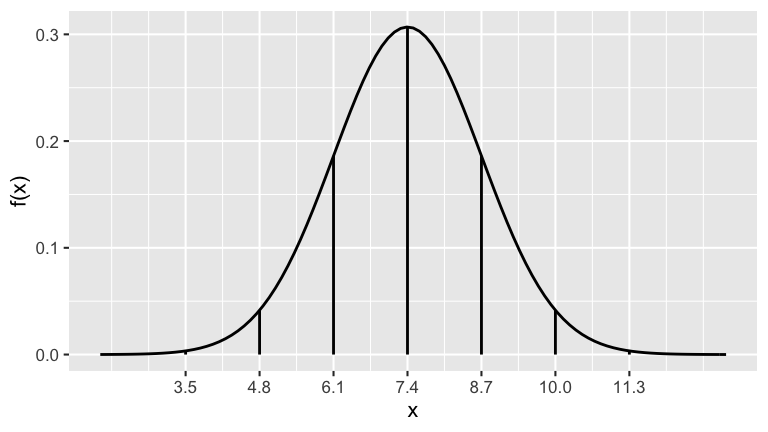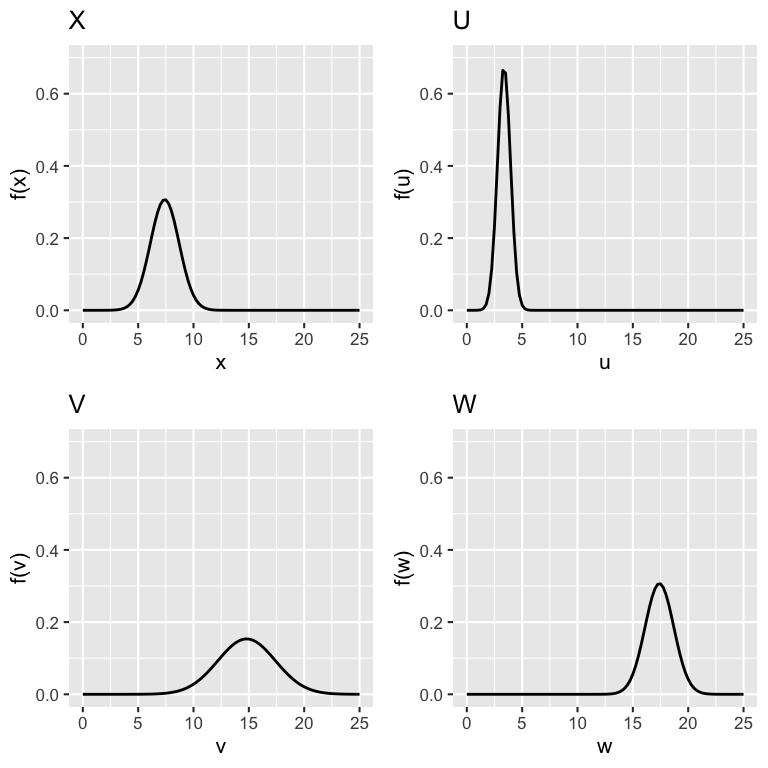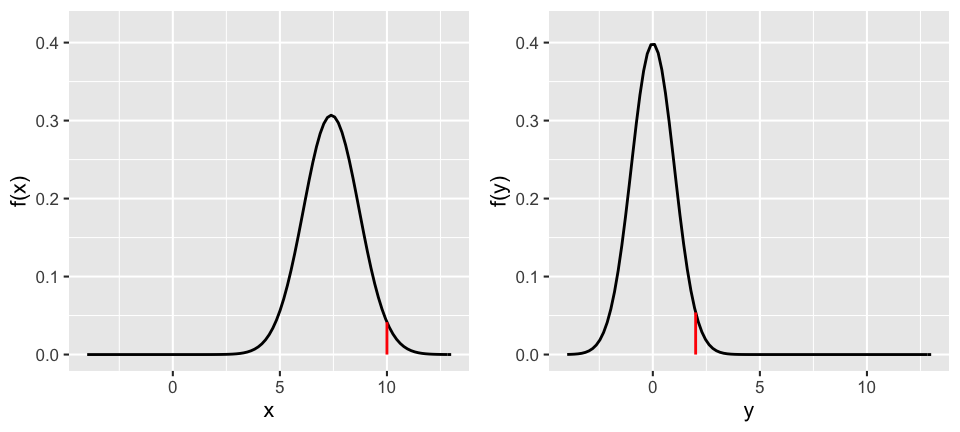15 Dusting off
Goals
Review:
- random variables (RVs)
- univariate models
- RV transformations
15.1 Review: RVs
A random variable \(X\) is a function from the sample space \(S\) to the real line \(\mathbb{R}\). That is, \(X\) is a numerical outcome of an experiment.
EXAMPLE
\(X\) is a baby’s birth weight (in pounds). A probability model of \(X\) describes:
- possible values of \(X\)
- relative plausibility of these values
A reasonable probability model for \(X\) is
\[X \sim N(7.4, 1.3^2)\]

Properties
probability density function (pdf) \[f(x) = \frac{1}{\sqrt{2\pi \cdot 1.3^2}} e^{-\frac{1}{2}\left(\frac{x - 7.4}{1.3} \right)^2}\;\; \text{ for } x \in (-\infty, \infty)\]
cumulative distribution function (cdf)
\[F(t) = P(X \le t) = \int_{-\infty}^tf(x)dx\]- \(E(X) = 7.4\) pounds
- \(Var(X) = 1.3^2\) pounds\(^2\)
\(SD(X) = 1.3\) pounds
Our current collection of named probability models
| model | common application | \(E(X)\) | \(Var(X)\) |
|---|---|---|---|
| Bin(\(n,p\)) | # of successes in \(n\) trials | \(np\) | \(np(1-p)\) |
| Geo(\(p\)) | # of trials until 1st success | \(\frac{1}{p}\) | \(\frac{1-p}{p^2}\) |
| Pois(\(\lambda\)) | # of events in a given time interval | \(\lambda\) | \(\lambda\) |
| N(\(\mu,\sigma^2\)) | RVs with bell-shaped distributions | \(\mu\) | \(\sigma^2\) |
| Exp(\(\lambda\)) | continuous waiting time for 1 event | \(\frac{1}{\lambda}\) | \(\frac{1}{\lambda^2}\) |
| Gamma(\(a,\lambda\)) | continuous waiting time for \(a\) events | \(\frac{a}{\lambda}\) | \(\frac{a}{\lambda^2}\) |
15.2 Review: Functions of RVs
For RV \(X\) (discrete or continuous), let \(Y\) be a linear transformation of \(X\):
\[Y = aX + b \;\; \text{ for } a,b \in \mathbb{R}\]
Such transformations are common. For example:
\(X\) = temperature in Fahrenheit
\(Y = \frac{5}{9}(X-32)\) = temperature in Celsius\(X\) = height in centimeters
\(Y = 2.54 X\) = height in inches
Examples
Let \(X\) be baby birth weight in pounds:
\[X \sim N(7.4, 1.3^2)\]
Consider 3 transformations of \(X\):
\[\begin{split} U & = 0.454 X \text{ (birth weight in kg)}\\ V & = 2X \\ W & = X + 10 \\ \end{split}\]

Properties of \(Y\)
Let \(Y = aX + b\). Then we can obtain the properties of \(Y\) from the properties of \(X\):
\[\begin{split} E(Y) & = a E(X) + b \\ Var(Y) & = a^2 Var(X) \\ \end{split}\]
Further,
\[\begin{split} X \text{ discrete } \Rightarrow \;\; & p_Y(y) = p_X\left(\frac{y - b}{a} \right) \\ X \text{ continuous } \Rightarrow \;\; & f_Y(y) = \frac{1}{|a|}f_X\left(\frac{y - b}{a} \right) \\ \end{split}\]
Interpretation
- \(a\) = a change in scale and \(b\) = a change in location
- The expected value of a RV is impacted by both a change in location (\(b\)) and scale (\(a\))
- The variance of a RV isn’t impacted by a change in location (\(b\)) but is impacted by a change in scale (\(a\)).
Proof
Assume \(X\) is continuous. The proof for discrete \(X\) is similar.
\[\begin{split} E(Y) & = E(aX + b) \\ & = \int (ax+b)f_X(x)dx \\ & = \int (axf_X(x) + bf_X(x))dx \\ & = a\int xf_X(x)dx + b\int f_X(x)dx \\ & = aE(X) + b \\ & \\ Var(Y) & = Var(aX + b) \\ & = E((aX+b - E(aX+b))^2) \\ & = E((aX - aE(X)))^2) \\ & = E(a^2(X - E(X))^2) \\ & = a^2 E((X - E(X))^2) \;\;\;\; \text{ (we've seen we can take constants out of E()} \\ & = a^2 Var(X) \\ & \\ \text{ when } a > 0: & \\ F_Y(y) & = P(Y \le y) \\ & = P(aX+b \le y) \\ & = P(X \le (y-b)/a) \\ & = F_X((y-b)/a) \\ f_Y(y) & = F'_Y(y) = \frac{1}{a}f_X((y-b)/a) \\ & \\ \text{ when } a < 0: & \\ F_Y(y) & = P(Y \le y) \\ & = P(aX+b \le y) \\ & = P(X \ge (y-b)/a) \\ & = 1 - P(X \le (y-b)/a) \\ & = 1 - F_X((y-b)/a) \\ f_Y(y) & = F'_Y(y) = \frac{1}{-a}f_X((y-b)/a) = \frac{1}{|a|}f_X((y-b)/a) \\ \end{split}\]
LINEAR TRANSFORMATION OF THE NORMAL
Let \(X \sim N(\mu,\sigma^2)\) with
\[\begin{split} f_X(x) & = \frac{1}{\sqrt{2 \pi \sigma^2}} e^{-\frac{1}{2}\left(\frac{x - \mu}{\sigma}\right)^2} \;\;\; \text{ for } x \in (-\infty,\infty) \\ E(X) & = \mu \\ Var(X) & = \sigma^2 \\ \end{split}\]
Let
\[Y = \frac{X - \mu}{\sigma} = \frac{1}{\sigma} X - \frac{\mu}{\sigma}\]
Show that:
- \(E(Y) = 0\)
- \(SD(Y) = 1\)
- \(Y \sim N(0, 1^2)\), ie. \(Y\) is standard normal.
NOTE: Similarly, if \(Y \sim N(0,1)\) and \(X = \sigma Y +\mu\), we could show that \(X \sim N(\mu,\sigma^2)\)!
PROOF:
Since \(Y = \frac{X - \mu}{\sigma} = \frac{1}{\sigma}X - \frac{\mu}{\sigma}\), \(Y = aX + b\) where \(a = 1/\sigma\) and \(b = -\mu/\sigma\). Thus
\[\begin{split} f_Y(y) & = \frac{1}{a}f_X\left(\frac{y -b}{a} \right) \\ & = \frac{1}{1/\sigma}f_X\left(\frac{y + \mu/\sigma}{1/\sigma} \right) \\ & = \sigma f_X\left(\sigma y + \mu \right) \\ & = \frac{\sigma}{\sqrt{2 \pi \sigma^2}} \exp\left\lbrace -\frac{1}{2}\left(\frac{(\sigma y + \mu) -\mu}{\sigma} \right)^2\right\rbrace \\ & = \frac{1}{\sqrt{2 \pi}} \exp\left\lbrace -\frac{1}{2}y^2\right\rbrace \;\;\; \text{ for } y \in (-\infty,\infty) \\ \end{split}\] which is the pdf of \(N(0,1^2)\). Further,
\[\begin{split} E(Y) & = \frac{1}{\sigma}E(X) - \frac{\mu}{\sigma} = \frac{1}{\sigma}\mu - \frac{\mu}{\sigma} = 0 \\ Var(Y) & = \frac{1}{\sigma^2} Var(X) = \frac{1}{\sigma^2} \sigma^2 = 1 \\ \end{split}\]
EXAMPLE: What’s the point?
Let \(X\) be baby birth weight:
\[X \sim N(7.4, 1.3^2)\]
And \(Y\) be the standardized value of \(X\):
\[Y = \frac{X - 7.4}{1.3} = \text{ the number of s.d. that $X$ is from 7.4}\]
For example, suppose a baby weighs \(X = 10\) pounds. Then their birth weight is 2 standard deviations above the mean:
\[Y = \frac{10 - 7.4}{1.3} = 2\]
